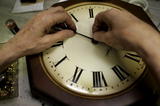 At 2 a.m. this Sunday, March 11, Daylight Saving Time begins in the United States. Daylight Saving Time begins the second Sunday in March at 2 a.m. when the clocks are adjusted one hour ahead to 3 a.m.
At 2 a.m. this Sunday, March 11, Daylight Saving Time begins in the United States. Daylight Saving Time begins the second Sunday in March at 2 a.m. when the clocks are adjusted one hour ahead to 3 a.m.
Remember to change the batteries in your smoke detectors when you change your clocks on Sunday.
Every spring we move our clocks one hour ahead and “lose” an hour during the night and each fall we move our clocks back one hour and “gain” an extra hour. But Daylight Saving Time (and not Daylight Savings Time with an “s”) wasn’t just created to confuse our schedules.
The phrase “Spring forward, fall back” helps people remember how Daylight Saving Time affects their clocks. At 2 a.m. on the second Sunday in March, we set our clocks forward one hour ahead of standard time (“spring forward”). We “fall back” at 2 a.m. on the first Sunday in November by setting our clock back one hour and thus returning to standard time.
The change to Daylight Saving Time allows us to use less energy in lighting our homes by taking advantage of the longer and later daylight hours. During the six-and-a-half-month period of Daylight Saving Time, the names of time in each of the time zones in the U.S. change as well. Eastern Standard Time (EST) becomes Eastern Daylight Time, Central Standard Time (CST) becomes Central Daylight Time (CDT), Mountain Standard Time (MST) becomes Mountain Daylight Tome (MDT), Pacific Standard Time becomes Pacific Daylight Time (PDT), and so forth.
Daylight Saving Time was instituted in the United States during World War I in order to save energy for war production by taking advantage of the later hours of daylight between April and October. During World War II the federal government again required the states to observe the time change. Between the wars and after World War II, states and communities chose whether or not to observe Daylight Saving Time. In 1966, Congress passed the Uniform Time Act which standardized the length of Daylight Saving Time.
Daylight Saving Time is four weeks longer since 2007 due to the passage of the Energy Policy Act in 2005. The Act extended Daylight Saving Time by four weeks from the second Sunday of March to the first Sunday of November, with the hope that it would save 10,000 barrels of oil each day through reduced use of power by businesses during daylight hours. Unfortunately, it is exceedingly difficult to determine energy savings from Daylight Saving Time and based on a variety of factors, it is possible that little or no energy is saved by Daylight Saving Time.
Arizona (except some Indian Reservations), Hawaii, Puerto Rico, the U.S. Virgin Islands, and American Samoa have chosen not to observe Daylight Saving Time. This choice does make sense for the areas closer to the equator because the days are more consistent in length throughout the year.
{Noam Amdurski-Matzav.com Newscenter}












i guess well wake up later on sunday
i guess well wake up later on sunday
Moti gets the Shmerel Prize 5772 for the most profound comment on a http://www.matzav.com report.
Zman krias shma & zman tfilla all spring forward an hour so go ahead & wake up late
Here in Arizona, we have none of this headache. Great!